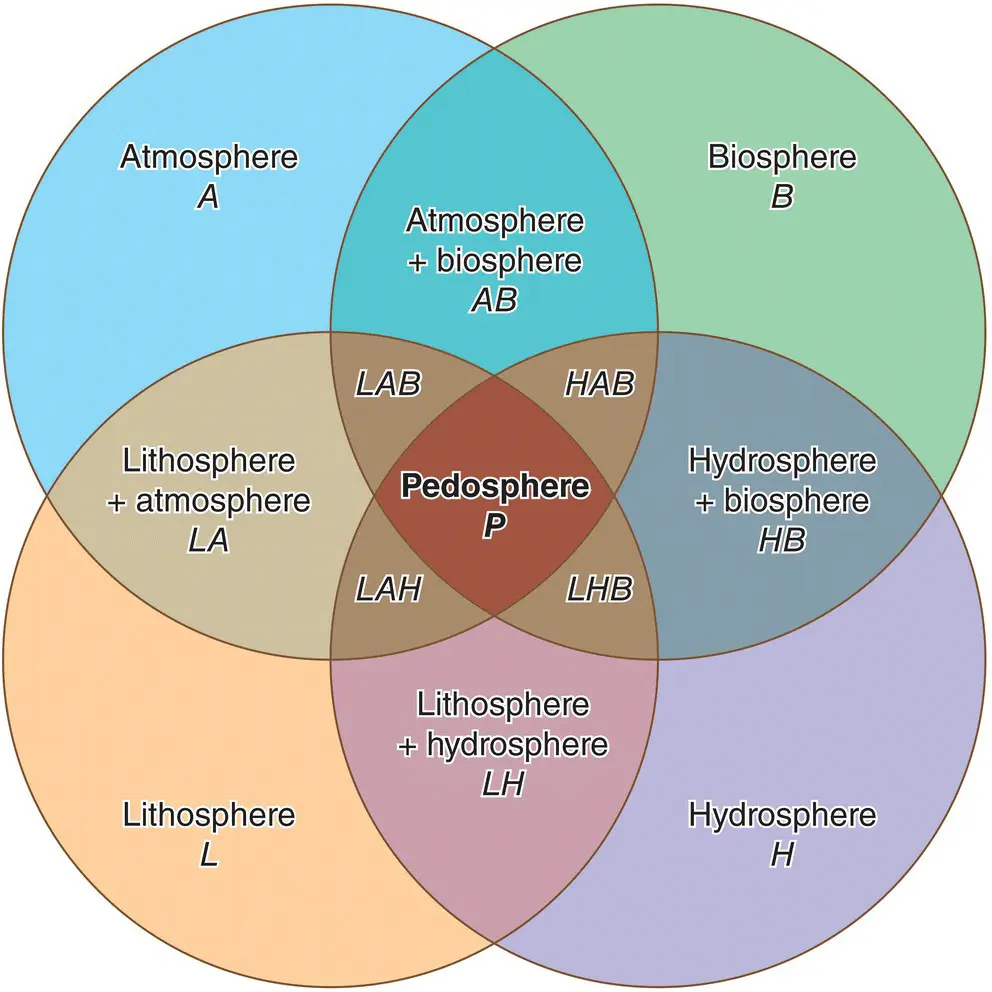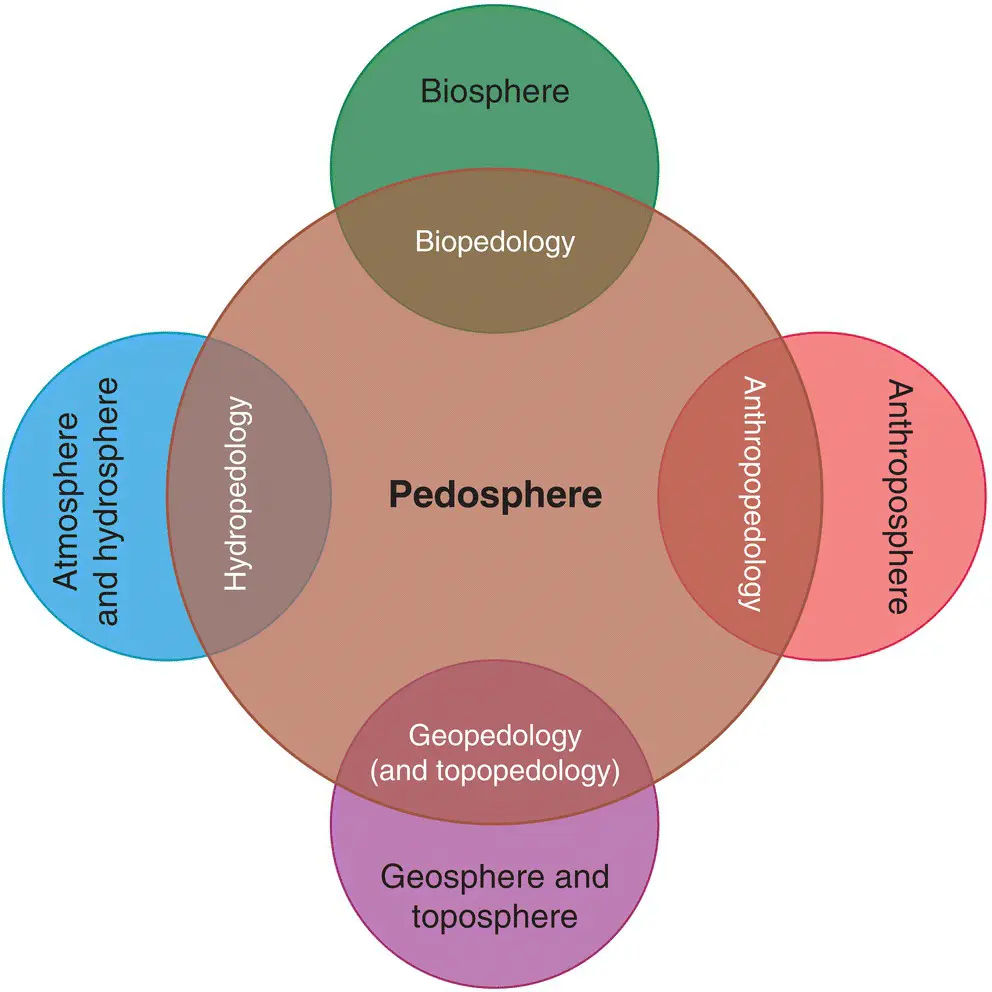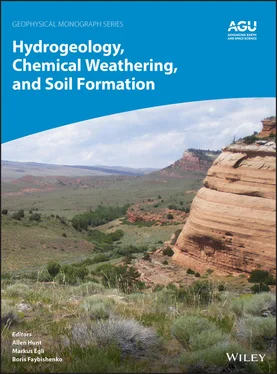
Figure 1.2 Terrestrial spheres and their interaction as envisioned by Sante Mattson. The shaded portion is the ecosphere, a term unknown to Mattson.
Source: Adapted from Mattson (1938).

Huggett (1995) argued that this approach reformulates the factorial model into mathematically solvable equations and models soil properties as a function of processes. Applications of these system equations can be found in Phillips (1993b), where it was shown in a numerical example that changes in the initial condition and parameter values can trigger the creation of chaotic behavior of soil development (see also Phillips, 1998).
The rise of Earth system science has led to an evaluation of the pedosphere’s role in the global system, both as a vital component of what has become known as the Earth’s critical zone and as a two‐way interactor with the other terrestrial spheres, the study of which has given rise to some new pedologies ( Figure 1.4). These topics will conclude the chapter.

Figure 1.3 A schema for the terrestrial spheres: their interactions and external influences. Before 1875, the only terrestrial sphere given a special name was the atmosphere. Then the Austrian geologist Eduard Suess (1875), in the last and most general chapter of a slim volume titled Die Entstehung der Alpen ( The Origin of the Alps ), invented the eminently helpful terms hydrosphere , lithosphere , and biosphere , with the Swedish agricultural chemist Sante Mattson adding the term pedosphere in 1938. The present author suggested the word toposphere as substitute for Julius Büdel’s (1982) relief sphere , which Büdel used to describe the totality of the Earth’s topography (Huggett, 1995, 1997; Huggett & Cheesman, 2002). The toposphere sits at the interfaces of the pedosphere and atmosphere and the pedosphere and hydrosphere; it is a complex surface separating the predominantly solid body of the Earth from its mainly gaseous and liquid outer envelopes.
Source: Adapted from Huggett (1995).

Figure 1.4 Research areas straddling the pedosphere and individual components of the Earth system. The word topopedology is suggested here, although there is a precedence for its use (Brillante et al., 2017).
As defined by the National Research Council (2001, 37), the critical zone is
a dynamic interface between the solid Earth and its fluid envelopes, governed by complex linkages and feedbacks among a vast range of physical, chemical, and biological processes. These processes can be organized into four main categories: (1) tectonics driven by energy in the mantle, which modifies the surface by magmatism, faulting, uplift, and subsidence; (2) weathering driven by the dynamics of the atmosphere and hydrosphere, which controls soil development, erosion, and the chemical mobilization of near‐surface rocks; (3) fluid transport driven by pressure gradients, which shapes landscapes and redistributes materials; and (4) biological activity driven by the need for nutrients, which controls many aspects of the chemical cycling among soil, rock, air, and water. [italics in original]
Henry Lin (2011) rightly pointed out that soils can be literally called the critical component of the Earth’s critical zone (see also Wilding & Lin, 2006).
A key feature of critical zone research is its integrative nature. The multifarious components of the critical zone have engaged scientists from distinct and often isolated disciplines: vegetation by botanists, soils by soil scientists, groundwater by hydrogeologists, and substrate by geologists. Important though such separate studies be, predicting the overall behavior of the critical zone demands a combined effort, not least because the functional, emergent properties of such a complex system are the result not only of its various parts but also of the interactions among its parts (Chorover et al., 2007). Recent publications point to the value of integrative modeling (e.g. Banwart et al., 2017). Critical zone research has gained enormously from National Science Foundation funding, and it has led to the increased inclusion of geochemical reaction models and concepts in soil science.
Biopedology, the oldest of the new pedologies, considers interactions between soils and life. Its origins lie with Charles Darwin and his work on earthworms (e.g. Darwin, 1881). Darwin was also the first to recognize the importance of faunal mixing in soil formation and the textural sorting it can produce (Johnson, 2002; Brevik & Hartemink, 2010). Biopedology has made a strong comeback in the last few decades with research into bioturbation and biomantle theory (e.g. Hole, 1961; Johnson, 1990; Peacock & Fant, 2002; Johnson et al., 2005a, 2005b; Saco & Moreno‐de las Heras, 2013; Gabet et al., 2014; Fleming et al., 2014; Johnson & Schaetzl, 2015); it is also benefitting from research in biogeomorphology (e.g. Verboom & Pate, 2013; Pawlika & Šamonil, 2018; see also Huggett, 2017).
The second oldest of the new pedologies is geopedology, which is short for geomorphopedology and focuses on the interdependency between soils and geomorphology. The argument is that soils and vegetation seldom develop in a totally inactive geomorphological environment: the landscapes in which soils and vegetation develop normally change. Thus, the development of terrestrial ecosystems and the geomorphological development of landscapes take place at the same time and influence one another. Pedologists were alerted to this fact by Shaw (1930), Robinson (1936), and Milne (1936), who discussed the role of erosion and deposition in soil evolution (see above). Indeed, soil geomorphology began in the USA in the 1930s with a spate of soil erosion studies made under the auspices of the USDA (Effland & Effland, 1992). In 1952, the USDA set up a Soil‐Geomorphology Group that included Robert V. Ruhe, who championed the process dimension of Milne’s catena concept (e.g. Ruhe, 1960), arguing that it is the clearest general systems statement about soil geomorphology, integrating the factors in explaining soil differences while focusing on past history of the land surface, geohydrology, erosion, sediment transport, and pedogenic processes (Ruhe, 1975; Birkeland, 1990; Johnson & Hole, 1994). Geopedology has blossomed over the last couple of decades (see Zinck et al., 2016) and the advent of sophisticated soilscape–landscape deterministic models has given it a new impetus (e.g. Willgoose, 2018).
Hydropedology is one of the latest pedologies. It is “an emerging intertwined branch of soil science and hydrology that studies interactive pedologic and hydrologic processes and properties in the Earth’s Critical Zone [and that] aims to bridge disciplines, scales, and data, connect soils with the landscape, link fast and slow processes, and integrate mapping with monitoring and modeling to provide a holistic understanding of the interactions between the pedosphere and the hydrosphere” (Ma et al., 2017). Unlike conventional soil science, it emphasizes in situ soils in the landscape, which have distinct pedogenic features and varying environmental settings (Lin et al., 2012). In doing so, it yields a more realistic and integrated understanding of real‐world soil and hydrological processes.
Читать дальше
















